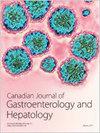乳酸和胆红素指数:预测危重肝硬化患者预后的新指标
IF 2.3
4区 医学
Q2 GASTROENTEROLOGY & HEPATOLOGY
引用次数: 2
摘要
目标。我们旨在对新指标乳酸和胆红素(LB)指数的预后价值进行外部验证,并比较LB指数和其他评分系统预测危重肝硬化患者短期和长期死亡率的能力。材料和方法。我们的研究包括479名入住ICU的肝硬化患者。我们测量了前24小时的预后评分,包括LB指数、Child-Pugh、SOFA、CLIF-SOFA和MELD评分。LB指数计算如下:ln[1000 × 乳酸(mmol/L) × 胆红素(µmol/L)]/2。主要转归为28天和3年全因死亡率。多变量逻辑回归分析用于研究LB指数与危重肝硬化患者死亡率之间的独立相关性。受试者操作特征曲线下面积用于评估临床评分对短期和长期死亡率的预测准确性。评分的校准通过Hosmer–Lemeshow拟合优度检验进行显著性评估。后果多元逻辑回归分析表明,LB指数(比值比:5.487,95%置信区间:3.542-8.501,P<0.001)是28天死亡率的最强预测因子。LB指数在预测28天死亡率方面给出了最高的曲线下面积(0.791,95%置信区间:0.747-0.836)。对于预测3年死亡率,终末期肝病(MELD)评分模型显示出更好的辨别能力,曲线下面积为0.726(95%置信区间:0.680–0.771)。当临床评分≥最佳临界值时,死亡率风险显著增加。结论。LB指数是一个简单的预后指标,在预测危重肝硬化患者的短期预后方面表现良好,而对于长期预后,MELD评分更合适。本文章由计算机程序翻译,如有差异,请以英文原文为准。
Lactate and Bilirubin Index: A New Indicator to Predict Critically Ill Cirrhotic Patients’ Prognosis
Objectives. We aimed to perform external validation of the prognostic value of the lactate and bilirubin (LB) index, a new indicator, and compare the ability of the LB index and other scoring systems to predict both short- and long-term mortality in critically ill cirrhotic patients. Materials and Methods. A number of 479 cirrhotic patients admitted into ICU were included in our research. We measured prognostic scores in the first 24 hours including LB index, Child–Pugh, SOFA, CLIF-SOFA, and MELD scores. The LB index was calculated as follows: ln [1000 × lactate (mmol/L) × bilirubin (µmol/L)]/2. The primary outcomes were 28-day and 3-year all-cause mortality. Multivariate logistic regression analyses were used to investigate the independent association between the LB index and the mortality in critically ill cirrhotic patients. The area under the receiver operating characteristic curve was used to assess the prediction accuracy of short- and long-term mortality of the clinical score. Calibration of the score was evaluated by Hosmer–Lemeshow goodness-of-fit test for significance. Results. Multivariate logistic regression analysis identified that the LB index (odds ratio: 5.487, 95% confidence interval: 3.542–8.501,
P
<
0.001
) was the strongest predictor for 28-day mortality. The LB index gave the highest area under the curve (0.791, 95% confidence interval: 0.747–0.836) in predicting 28-day mortality. For predicting 3-year mortality, the model for end-stage liver disease (MELD) score showed better discrimination ability with an area under the curve of 0.726 (95% confidence interval: 0.680–0.771). The risk of mortality significantly increased when the clinical scores were ≥ the optimal cutoff values. Conclusions. The LB index, a simple prognostic indicator, performs well in predicting critically ill cirrhotic patients’ short-term prognosis, while, for long-term prognosis, the MELD score is more appropriate.
求助全文
通过发布文献求助,成功后即可免费获取论文全文。
去求助
来源期刊

Canadian Journal of Gastroenterology and Hepatology
Medicine-Hepatology
自引率
0.00%
发文量
90
期刊介绍:
Canadian Journal of Gastroenterology and Hepatology is a peer-reviewed, open access journal that publishes original research articles, review articles, and clinical studies in all areas of gastroenterology and liver disease - medicine and surgery.
The Canadian Journal of Gastroenterology and Hepatology is sponsored by the Canadian Association of Gastroenterology and the Canadian Association for the Study of the Liver.
 求助内容:
求助内容: 应助结果提醒方式:
应助结果提醒方式:


